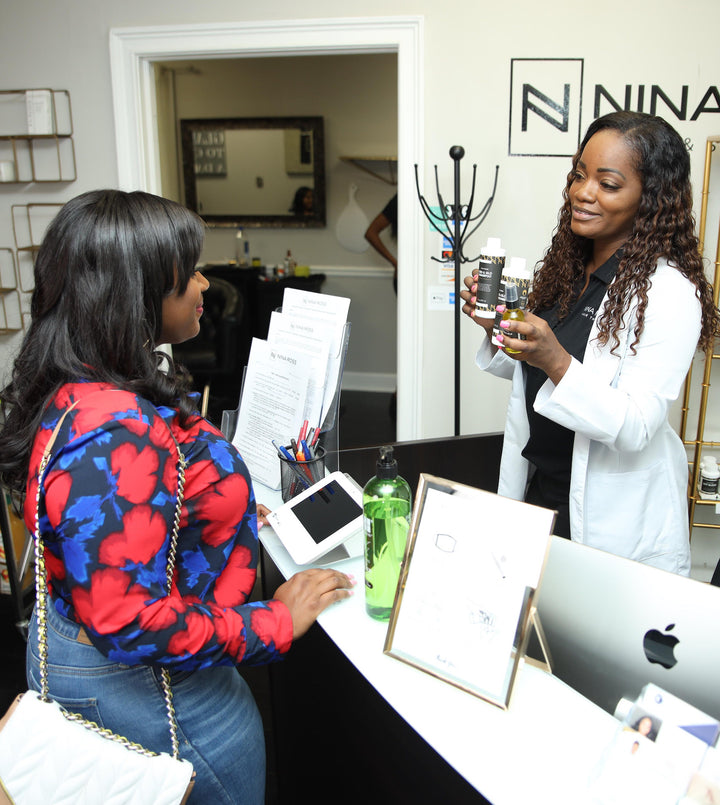I need you to do something right now. Run your fingers along your hairline. Feel that? The sparse areas where hair should be. The tiny broken strands that never seem to grow past a certain length. The smooth patches that feel different from the rest of your scalp.
If you're like most women who walk into our Atlanta clinic, you've been watching this slow retreat for months—maybe years. You switched to softer styles, you moisturized, you prayed. But the damage seems to be... sticking around.
That sinking feeling in your stomach? I know it well. Let's talk honestly about when traction alopecia crosses from "reversible" to "permanent"—and what we can actually do about it at each stage.
The 3 Stages of Traction Alopecia (And What Each Feels Like)
Stage 1: The "This Hurts But It's Cute" Phase
-
Your scalp is tender after styling.
-
You see redness and tiny bumps along your hairline.
-
Your "baby hairs" look broken and uneven.
The truth: This is 100% reversible if you act now
Stage 2: The "Okay, This Is Getting Real" Phase
-
Actual gaps are appearing in your hairline.
-
The hair that grows back is finer and weaker.
-
You're developing headaches from the tension.
The truth: We can still recover about 70-80% with aggressive treatment
Stage 3: The "Smooth and Shiny" Phase
-
You can feel smooth, slick skin where hair used to be.
-
The follicles feel like they've "closed up".
-
No regrowth despite changing your styling habits.
The truth: This indicates scarring—the point where we're saving what's left rather than regrowing what's lost
How We Know When It's REALLY Too Late
Here's what I look for during scalp examinations that tells me we're dealing with permanent damage:
The Shiny Test: Healthy scalp has microscopic pores where hair emerges. Scarred scalp looks smooth and shiny under magnification—like plastic wrap has formed over it.
The Texture Change: Scar tissue feels different—denser, tighter, less flexible than healthy scalp skin.
The Blood Flow Check: Using trichoscopy, we can see if there's still blood flow to the follicles. No blood flow means the follicle has suffocated.
But here's what most women don't know: even in Stage 3, we can often reactivate surrounding follicles to compensate for the scarred ones. It's not about regrowing hair from dead soil—it's about making the living soil more productive.
Our Approach: We Maximize Recovery at Every Stage
For Early Stage Damage:
We use scalp detox treatments that will help reduce inflammation and growth serums to stimulate your dormant follicles. At this stage, even the simple changes can bring back 100% of your hairline.
For Moderate Damage:
We use PRP therapy to increase the blood flow and low-level laser therapy to reverse miniaturization. Typically, it takes around 6-9 months of consistent treatment to see significant improvement.
For Advanced Scarring:
This is where we go with more effective treatments like exosome therapy to regenerate damaged tissue and micro-needling to break up scar tissue. While we may not recover every single hair, we can usually create enough density so that you won’t notice much of the thin areas.
The Treatments That Actually Work (And What's Wasteful)
You shouldn’t waste any more money on:
-
Growth oils that can't penetrate scar tissue.
-
Vitamins when the problem is physical damage.
-
Topical creams that never reach the follicle bulb.
Actually invest in:
-
Professional diagnosis to know exactly what you're dealing with.
-
Medical-grade treatments that reach deeper than surface level.
-
Consistent follow-up to track progress and adjust protocols.
Your "Am I Too Late?" Checklist
Come see us immediately if:
-
You've noticed thinning for over a year
-
The skin along your hairline looks different than other scalp areas
-
You've stopped wearing tight styles but the hair hasn't returned
-
You're developing tension headaches or scalp pain
The women who recover best are the ones who come in at the first sign of trouble. But I've also seen miraculous recoveries in women who thought they were "too far gone."
What Recovery Actually Looks Like
It's not overnight. It's watching tiny colorless hairs gradually thicken and darken over months. It's measuring your progress in millimeters rather than inches. It's the relief of being able to pull your hair back without strategically placed concealer.
Most importantly, it's stopping the progression before more follicles are lost forever.
Ready to Save What's Left?
If you're staring at your hairline in the mirror and wondering if you've crossed the point of no return, book your Hair Therapy Evaluation with us today for just $99. Let's assess the damage honestly and create a plan to save—and hopefully regrow—your edges.














